Five key nutrients: Calories, Sugar, Fat, Saturated Fat and Salt
The information on this page is historical. Food labels are changing and the term Guideline Daily Amount is being replaced by Reference Intake (RI). Read about the new nutrition labelling requirements.
Using GDA labels will help you evaluate how a particular food fits into your daily meal plan and
should help you manage your intake of calories and key nutrients; sugars, fat,
saturates (saturated fat) and salt.
Although these key nutrients form an important part of a balanced diet,
unfortunately many people tend to consume too much of them. Long term
overconsumption of calories in combination with a lack of physical activity is
associated with gaining weight and obesity, which increases risk of poor health
and various
diseases.
Eating too much of these nutrients when you are already at high risk for high
blood pressure, high cholesterol and high blood glucose, could further increase
risk of heart disease, stroke, diabetes and even some cancers.
Those who take part in extensive activity, those who are not active at all,
pregnant and breast feeding mothers and those on a special diet for whatever
reason,
will need to seek more particular nutrition advice for their needs.
If you have any specific queries or concerns about your diet it is advised you
speak to your doctor, practice nurse or registered dietitian as they will be
able
to give you individual advice and guide you in the right direction. To find a
registered dietitian contact the British Dietetic Association.
Calories (Energy GDA: 2,000 kcal)
Calories are a measure of how much energy food and drink products contain. The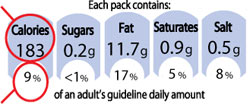 calories a food delivers depend on the nutrients it contains. A gram of
carbohydrates has four calories, just like a gram of protein. One gram of fat
instead has nine calories and a gram of alcohol seven calories.
calories a food delivers depend on the nutrients it contains. A gram of
carbohydrates has four calories, just like a gram of protein. One gram of fat
instead has nine calories and a gram of alcohol seven calories.
You should limit your calorie intake because if you do not use all
the energy stored in the food you eat the excess will eventually be stored as
fat. Being overweight is a direct consequence of excessive calorie/energy
intake,
which
in
turn can increase the risk of conditions such as heart disease, diabetes, high
blood pressure and ill health.
Eating too few calories is just as damaging to your general wellbeing and can
lead to serious health conditions caused by nutrient deficiencies.
The Guideline Daily Amount for energy is 2,000 calories, which is based on UK
government recommendations and is considered by experts as being an
appropriate
value for adults.
Sugars (Sugar GDA: 90g)
Sugars, together with starches, are the two main types of carbohydrates and the
main sources of energy. 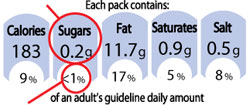
Sugars include sucrose (table sugar) and many other
types of sugars naturally found in foods such as fruits, vegetables, milk
products and glucose found in soft drinks.
Sugars provide a sweet taste, texture, structure and consistency to foods; these
are some of the reasons why they are added to foods during food processing.
Sugars play a role in
functions of the body; the brain needs glucose (a simple sugar) as its only
source of energy and
the
body's tissues use sugar (stored in liver and muscles) to carry out their main
functions.
While neither starch nor sugars have been found to have any special role in the
development of serious diseases such as diabetes it is still important to keep
an eye on their intake if you are already suffering from some diet-related
medical condition, if you are watching your waistline, and to limit the risk of
tooth
decay.
The Guideline Daily Amount for sugars is 90 grams.
Fat (Fat GDA: 70g)
Fat provides energy (nine calories for each gram of fat), and foods that contain
a
lot of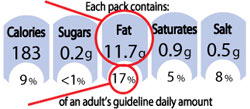 fat provide a lot of energy.
fat provide a lot of energy.
Fat is made up of different types of fatty
acids. You can have monounsaturated (such as those found in nuts and vegetable
oils), polyunsaturated (such as those found in oily fish) and saturates fatty
acids (such as those found in butter and animal fat). Whilst monounsaturated
and
especially polyunsaturated fatty acids are good for our health, a high intake
of saturated fatty acids can have a negative impact on health, which is why we
can
have a GDA for both total fat and saturates (saturated fat), so we can help you
keep an eye on your intakes.
It is important to have some fat in our diet because it's a critical nutrient
for many functions that take place in our body and because some of them (the
essential fatty acids) cannot be produced by our body and must be supplied by
the
diet.
Fats are important for the formation of hormones, which carry fat-soluble
vitamins, and are necessary for their absorption. However fat is only needed
for health in small amounts. No more than about
one third
of our energy intake should come from fat.
Some
examples of foods high in fat are oils, butter, full-fat milk and cheese, pies
and pastries.
The Guideline Daily Amount for fat is 70 grams, which corresponds to a third of
energy based on a 2,000 calories diet.
You will see on the food label GDAs for both fat and for saturates (saturated
fats). The GDA
figure for fat is the total amount of fat a food contains - this includes
saturated and unsaturated fats.
Saturated fat (Saturates GDA: 20g)
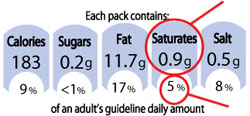 Saturates (saturated fat) are the type of fat you should try to eat less of
because too
much can increase the amount of cholesterol in the
blood, which
in
turn increases the chance of developing heart disease. Eating less of it
minimises the risks.
Saturates (saturated fat) are the type of fat you should try to eat less of
because too
much can increase the amount of cholesterol in the
blood, which
in
turn increases the chance of developing heart disease. Eating less of it
minimises the risks.
Experts recommend that not more than 10 percent of your calories should come
from
saturates (saturated fats). This means that on a 2,000 calorie diet you
shouldn't
eat more
than
20g per day.
Some examples of categories of foods high in saturates (saturated fats) are meat
products
and pies, sausages, hard cheese, butter, pastry, cakes and biscuits, cream and
palm oil.
The Guideline Daily Amount for saturated fat is 20 grams.
Salt (Salt GDA: 6g)
Salt is made up of sodium and chloride and it's the sodium that, at high doses,
can be bad for your health. 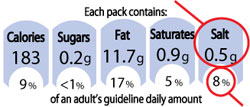
Sodium together with other nutrients plays many important roles; for example, it
helps to regulate the body's water content and it's involved in nerve function,
in
muscular activity and in energy utilisation.
Salt is used in food manufacturing as a flavour enhancer, a food preservative,
to inhibit microbiological spoilage and to give texture to some foods.
An excessive intake of salt (sodium) in the diet can increase the risk of high
blood pressure which is a risk factor for heart disease and stroke. This is why
it is generally recommended to limit the daily intake of salt to 6 grams (2.4g
sodium) and to check and compare the salt/sodium content of a food on the
front of pack or back of pack nutrition labels.
The Guideline daily Amount for salt is 6 grams (2.4 grams sodium).